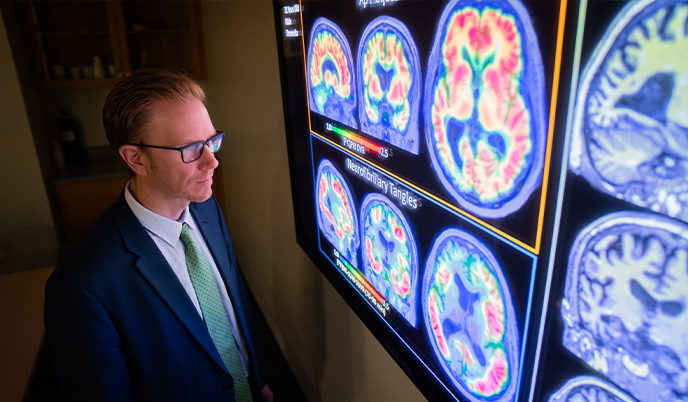UW–Madison receives $150 million grant to lead nationwide Alzheimer’s disease study
The University of Wisconsin School of Medicine and Public Health has been awarded funding from the National Institutes of Health for a nationwide research initiative to investigate the neurobiology of Alzheimer’s disease and related dementias.
The five-year study will provide state-of-the-art imaging and blood-based biomarkers for researchers around the world to study and advance the field of Alzheimer’s and related dementias. The work is also designed to shed light on mixed dementia, where more than one neurological disease is contributing to dementia.
Researchers are beginning to understand that mixed dementia occurs more frequently than had been realized and can cause multiple changes in the brain. For example, an individual may be initially diagnosed with and treated for Alzheimer’s disease, but their brains may also show signs of vascular dementia, which impairs blood flow in the brain. Or, they may also have Lewy body dementia, which involves a brain protein called alpha-synuclein. Without knowing the true cause of a patient’s dementia, physicians can’t properly treat them, according to Sterling Johnson, study leader and professor of medicine at UW School of Medicine and Public Health.

“This study represents a significant milestone in Alzheimer’s research,” said Johnson, who holds a doctorate in clinical neuropsychology. “By collaborating across our Alzheimer’s Disease Research Centers network, we can shed light on the complex interplay of multiple pathologies contributing to dementia, ultimately advancing our understanding and treatment of this devastating condition.”
The new study, called Clarity in Alzheimer’s Disease and Related Dementias Research Through Imaging, or CLARiTI, will gather data showing the presence, absence or change in characteristic disease biomarkers in people who have dementia or are at risk of developing it. The study will involve all of the 37 Alzheimer’s Disease Research Centers in the United States, establishing a standardized brain imaging and blood plasma test protocol to analyze levels and types of two proteins, amyloid and tau, which are hallmark biomarkers of Alzheimer’s disease. Researchers will also assess the function of small blood vessels in the brain and analyze signs of neurodegeneration.
Currently, Alzheimer’s Disease Research Centers follow a cohort of more than 17,000 participants, which includes the largest group of research participants available in the United States, some of whom live with dementia. Participants already receive uniform assessments and eventual neuropathology workup, but CLARiTI researchers will add standardized imaging of amyloid, tau and neurodegeneration biomarkers, which will provide a critical foundation of data on which future research can build, according to Johnson.
“As a consortium, these centers can collect, share and analyze hundreds of unique imaging-plasma sets which will be intrinsically linked to cognitive and neurobehavioral data collection, genetics and eventually neuropathology,” Johnson said. “This collaboration addresses a critical research gap while also building a bridge to future uniform blood-biomarker characterization in the Alzheimer’s Disease Research Centers, expanding the reach and impact of these research centers.”
Centers participating in CLARiTI will enroll a total of 2,000 participants at sites nationwide, collecting magnetic resonance imaging and positron emission tomography, or PET, brain scans, as well as advanced blood biomarkers. This will allow researchers to correlate biological changes to clinical diagnoses, genetics and changes in patient symptoms over time.
The grant, with anticipated funding totaling up to $150 million over five years, is the largest funding award from the NIH in the history of UW–Madison. The research is aimed at supporting progress in clinical care for Alzheimer’s disease and related dementias, according to Dr. John Hsiao, program director at the National Institute of Aging.
“The goal of this study is to help researchers better understand the full range of problems in the brain that may cause dementia,” Hsiao said. “We anticipate the results will help researchers develop better treatments for Alzheimer’s disease and other devastating dementias.”
Recruitment will be conducted through the Alzheimer’s Disease Research Centers with existing participants who are 55 years old or older. The study will include participants who are cognitively unimpaired and those with mild cognitive impairment or dementia. Volunteers will participate in CLARiTI for up to 36 months, and once their participation ends, will continue to be followed by the Alzheimer’s Disease Research Centers.
The research team aims to recruit at least one quarter of participants from communities historically underrepresented in research, according to Johnson.
“In our pursuit of clarity in this research, it is crucial to recognize that diversity is not just the goal; it is an imperative,” he said. “Health disparities are associated with a broad, complex and interrelated array of factors and it is vital we ensure our findings are applicable to all individuals affected by these devastating conditions.”
Data generated from CLARiTI will be made available to the scientific community through the National Alzheimer’s Coordinating Center, and biological samples will be analyzed and made available through the National Centralized Repository for Alzheimer’s Disease and Related Dementias, significantly accelerating scientific discovery within the Alzheimer’s Disease Research Centers network and beyond.
This project is funded by NIH grant U01AG082350. The content of this news release is solely the responsibility of the authors and does not necessarily represent the official views of the NIH.